News
Be responsible and take precautions: DG urges public
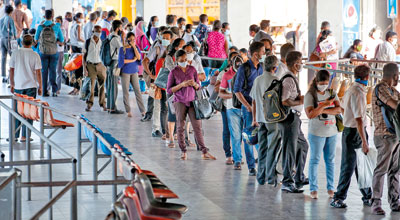
Central bus stand Pettah: Crowds paying scant regard for health measures. Pic by Sameera Weerasekera
An urgent call went out from a top health official seeking the people’s support to closely protect the gains Sri Lanka has made against the new coronavirus.
With lots of countries falling like dominoes under the inexorable onslaught of SARS-CoV-2 which spreads COVID-19 like wildfire, the Director-General (DG) of Health Services, Dr. Anil Jasinghe urged people to be conscious of the threat and get mobilized, as Sri Lanka gradually opens up and life returns to the new-normal.
“There is no 100% guarantee that we are safe against the virus, so people need to safeguard themselves and stringently follow the preventive health measures of social distancing, hand-hygiene and wearing masks in public places and on public transport. Avoid public gatherings,” he said.
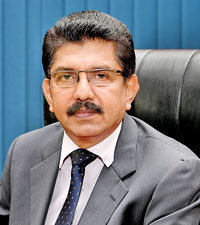
Dr. Anil Jasinghe
Dr. Jasinghe’s plea came as the navy cluster reduced rapidly this week, with high numbers being diagnosed only among the returnees, with only 85 patients at the National Institute of Infectious Diseases (NIID). There has been no community transmission in Sri Lanka so far.
From June 15 to 19, the number of positive cases was 57 and included 11 navy personnel and 46 returnees. The total confirmed cases stood at 1,948, with 1,446 recoveries and 11 deaths.
The DG reiterated that people need to be hondatama (thoroughly) alert to ensure that even if the virus was around in the country it would not spread.
“For this, each one of us should take all precautions, starting with ourselves, our immediate families, our neighbours, our co-workers and society. If there is any doubt, check the detailed guidelines for each and every scenario on the Health Ministry website,” he added.
This was as experts, both here and abroad, allayed the fears of people and told them not to be alarmed over reports that a woman from Kebithigollewa had tested positive for COVID-19 after being treated and discharged from hospital.
Their explanation was simple and evidence-based – after recovery, patients may rarely test positive as they are shedding the dead virus.
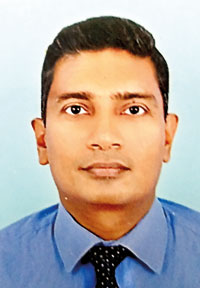
Dr. Eranga Narangoda
The person is not infectious and there is nothing to fear, reiterated NIID’s Consultant Physician Dr. Eranga Narangoda who treated the 36-year-old returnee from Kuwait. She had been discharged after two RT-PCR tests turned negative with the clinical evaluation also confirming that she was free of disease.
After her long journey to Kebithigollewa, she had experienced abdominal pain and begun vomiting and been admitted to the Anuradhapura Teaching Hospital, where the test for COVID-19 had become positive.
“She was sent to the NIID once again and we treated her for the vomiting. We tested her again and she was negative. She was not re-infected by COVID-19 and neither was she infective,” Dr. Narangoda told the Sunday Times.
Explaining that the RT-PCR test which is a diagnostic one was not that good in monitoring patients, he said that even if there is a small part of the virus’ RNA while the recovered patient is shedding it, the test could become positive. It was the same with a person who had been admitted to a hospital some time ago, a month after discharge from the NIID. He had suffered a heart attack, not been re-infected by the virus.
“Once a recovered COVID-19 patient is discharged, the ideal test would be an antibody test to determine whether the person has developed antibodies. If there are antibodies, then for some time, that person would be immune to the new coronavirus, while also not being infective,” said Dr. Narangoda.
How long this kind of immunity would last is still not known as this is a new virus, but testing for antibodies should be done three days after a person turns asymptomatic. That means it would be about 10 days after catching the infection, the Sunday Times learns.
Looking at other viruses, he said that when you get infected, you develop immunity and become positive for antibodies in about seven days. However, with the new coronavirus the antibodies develop in the second week after infection.
The NIID has a machine to test for antibodies and is awaiting the reagents to begin testing, it is learnt.
Clarifying the situation further and also stressing that people should not panic, Consultant Medical Virologist, Dr. Jude Jayamaha, of the Department of Virology, Medical Research Institute, said rarely even after a person has recovered from the new coronavirus, disintegrating particles or genetic material of the virus may be present in the epithelial cells of the respiratory tract, which usually get replaced in 30 days.
“The fluff of the virus may be found on and off after a few days or weeks of recovery and because the real-time RT-PCR testing is highly sensitive it would even catch these minute amounts. There was a scare in South Korea about 202 people getting re-infected which was dispelled by that country’s National Health Council,” he said.
He added that in the case of the new coronavirus, there was no ‘recrudescence’ (recurrence) like in malaria or re-infection. Very importantly, these people are not infective and cannot pass on the virus to others.
Concern over boat people bringing in the virus
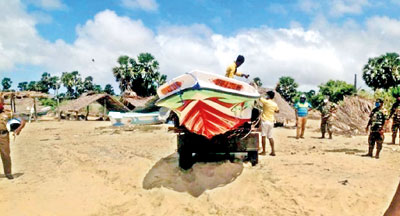
The boat in which a man and his daughter came illegally to Talaimannar was intercepted by the navy and police. Pic by Ramesh Madusanka
The danger of boatloads of people crossing over to Sri Lanka surreptitiously and setting off the spread of COVID-19, is causing grave concern among many.
“We have managed to prevent community transmission but this type of boat-landings could pose a major threat,” many sources said.
These fears were sparked by the seizure of a boat off Talaimannar on June 7, with a man and his daughter from a refugee camp in Tamil Nadu, India. The boat had been intercepted by the navy and the two persons had been taken into custody by the Madhu Police.
Investigations had revealed that six more people had arrived in Jaffna. They had been arrested while hiding in the area and along with the other two had been sent into quarantine at the Punanai centre.
When asked, Navy Spokesman Lt. Com. Isuru Suriyabandara said that they had launched special sea operations from the beginning of the COVID-19 pandemic to thwart illegal immigrants from coronavirus-hit countries coming here.
“We strengthened operations off the north and north-western coast, where there are many fishing clusters, since they could be used as a cover by smugglers. We were also alert for human and drug smuggling,” he said, adding that they were supported by the army, police and coast guard, with the Air Force carrying out reconnaissance flight.
Meanwhile, other reports indicated that the Mannar Police Intelligence Officers detected six more people whose visas had expired but were hiding in Mannar. They were produced before the Mannar courts and investigations are on to ascertain how they came into the country.
The security forces are urging the public in the north to be alert about strangers in their areas.
Across the Palk Straits, the Sunday Times found that as of June 17, there were 354,065 confirmed COVID-19 cases in India, which included 155,227 ‘active’ cases and 11,903 deaths. This was while there were 2,003 deaths in 24 hours on Wednesday
(June 17).
Many serious issues over sample-taking at the BIA
All those arriving at the Bandaranaike International Airport (BIA), Katunayake, are being tested for COVID-19, with samples being taken there and then despatched to various laboratories to get real-time RT-PCR results.
There are many serious issues about how the samples are taken, not only the safety of those taking the samples but also the returnees, the lack of facilities, the lack of training in sample-taking and the high risk of the spread of COVID-19, a source said.
The samples are taken in the side-corridor that leads out of the arrivals’ hall of the airport, the Sunday Times learns.
As of June 19, 10,662 have returned to the country from America, United Kingdom, Italy, Ukraine, Istanbul, Russia, Doha, Dubai, Kuwait, India, Pakistan, Nepal, Singapore, Malaysia, Bangkok, Myanmar, South Korea, China and Australia. Since sample-taking at the BIA was launched in early June, 2,279 samples have been taken of 1,806 passengers and 473 airline crew.
The source who wished to remain anonymous cited the case of a flight which arrived from West Asia with close to 300 passengers this week, with about 20 healthcare workers (about five doctors and nurses, medical laboratory technicians and others) taking these samples.
The passengers are tired, agitated and in a hurry to leave the airport and as such are not very cooperative, said the source, pointing out that they cough and sneeze when and after the nasopharyngeal swab is taken. They grab any tissue that is available and where they dispose of it is not known. They also keep removing their face-masks. This could lead to infection of others throughout. As they are not cooperative and the staff has got only a simple training, the quality of the samples are also questionable and could result in false negatives.
The source lamented that as flights get delayed, the sample-taking staff, who have come from different areas including far away, has to be in Personal Protective Equipment (PPE) for a long time. They are tired and dehydrated.
“We also do not have facilities to change our clothes, into PPE and out of PPE. Some of us walk around here and there in our PPE looking for a place to change and this could be risky as the disease could spread if the PPE is contaminated. Some change in their vehicles, some out in the open in the corridor and others walk around looking for a place to change,” the source said, giving the Sunday Times an insight into the not-so-smooth system, even though airport officials have kept touting that everything is under control.
With the airport being the most likely entry-point for a massive wave of COVID-19, once opened as proposed on August 1, many urged the authorities to get their act right.
“A disaster waiting to happen,” is the belief, with allegations of in-fighting and territorial issues within the airport.
With the entry-points gradually being opened, the BIA’s departure terminal visitor hall opened its doors on June 15 (Monday), after nearly three months. A passenger can be accompanied by a maximum of three visitors.
SARS-buster on negatives turning positive, new wave in China and dexamethasone
Patients can remain positive for a long period of time, sometimes longer than a month or even two. Often these patients test negative but then positive again. It is always low levels of the virus, said Prof. Malik Peiris, Professor of Virology at the School of Public Health, Hong Kong University, when asked by the Sunday Times about the Sri Lankan who tested positive after discharge from hospital.
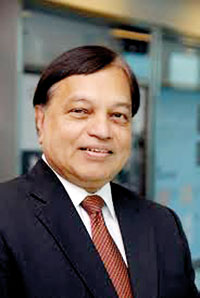
Prof. Malik Peiris
“Studies done by others and also us show that 14 days after illness-onset and once the patient has fully recovered from the symptoms, such low-level virus shedding is not highly infectious. In fact, Hong Kong changed its guidelines for the discharge of patients who have recovered from COVID from hospital a few months ago and we do not necessarily need to have negative PCR before patient discharge. I believe the WHO is also likely to make such a change,” he said.
With regard to a new wave hitting China, Prof. Peiris said the virus outbreak was caused by a European lineage virus, likely introduced via travel from Europe. But this did not mean that the virus was behaving differently in any way. Any lineage of virus can cause major outbreaks, similar to what happened in Wuhan in January/February.
When asked what a European lineage virus means, he said that there are signatures of mutations that can identify different geographic regions in a broad way to determine the ‘source’ of the virus. But this did not mean any change in the behaviour of the virus. There is one mutation in the spike protein of the virus which is now being recognised as possibly increasing virus fitness and perhaps transmission.
Dexamethasone
The study on the benefits of dexamethasone shows how important well-designed clinical trials are, says Prof. Peiris, pointing out that dexamethasone and other corticosteroids have been used for a long time in patients with severe life-threatening pneumonia, but they have never been proven to be of benefit. There was some evidence, however, that uncontrolled use early in the disease can do harm.
“What this study shows is that dexamethasone is beneficial in patients who are severely ill – those in need of oxygen or are in the ICU, not in mild patients. We did use corticosteroids (a similar drug) during SARS in 2003 and it made a difference in some patients. But then, clinicians started using it earlier and earlier in the illness and this led to possible harm,” he says.
Prof. Peiris explains that dexamethasone and other corticosteroids suppress the immune system. So what is being done is to dampen down the “cytokine storm” that some patients develop which can lead to severe lung damage and death. But if you use it too early, the normal control immune mechanisms may also be impaired. So, it has to be used carefully.
The study on dexamethasone is being conducted in the United Kingdom by the University of Oxford and many hospitals. Corticosteroids usually provide relief for inflamed areas of the body especially in the case of severe allergies, skin problems, asthma or arthritis.

